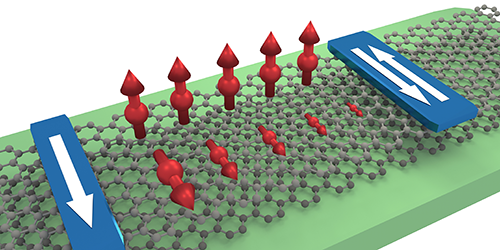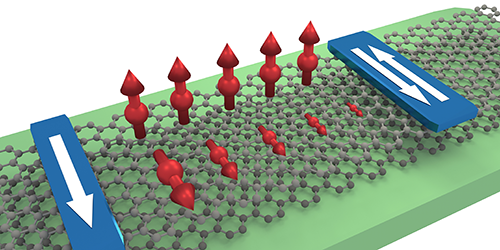Anisotropic Spin Currents in Graphene
Graphene’s exceptional electrical conductance makes it a prime target for spintronics technologies, which exploit the spin of the electron for data storage and transfer. However, it’s hard to manipulate the spins of graphene’s electrons because of weak spin-orbit coupling—the coupling between an electron’s spin and its motion. Researchers have circumvented this problem by placing graphene layers on transition-metal dichalcogenide (TMD) materials with strong spin-orbit coupling. But in doing so, they compromise graphene’s electrical properties. Now two teams have shown that they can manipulate spin-orbit coupling in graphene bilayers so that the lifetimes of two perpendicularly polarized spin currents in the material are significantly different. These graphene bilayers could be used as the basis for spin polarizers, which transmit spins that are polarized in a preferential direction.
The groups built on a recent theory for graphene bilayer structures, which predicted that an electric field could induce an asymmetric spin-orbit coupling in the material. The coupling would be weaker for “out-of-plane” spins, which point in the direction perpendicular to the graphene layer. These spins would stay polarized longer than spins pointing “in plane,” whose lifetimes would be reduced by dephasing effects caused by changes in graphene’s band structure that would be induced by the electric field.
Johannes Christian Leutenantsmeyer from the University of Groningen, Netherlands, and colleagues, and Jinsong Xu from The Ohio State University, Columbus, and colleagues have now confirmed experimentally that electric fields can induce asymmetric spin-orbit coupling in graphene bilayers. Leutenantsmeyer’s and Xu’s teams achieved out-of-plane spin currents up to 12 times larger than the in-plane counterparts. In the experiments of both teams, the currents stayed polarized for around 9 ns, a polarization lifetime over 100 times longer than that previously achieved in graphene-TMD bilayers.
This research is published in Physical Review Letters.
–Katherine Wright
Katherine Wright is a Senior Editor of Physics.





